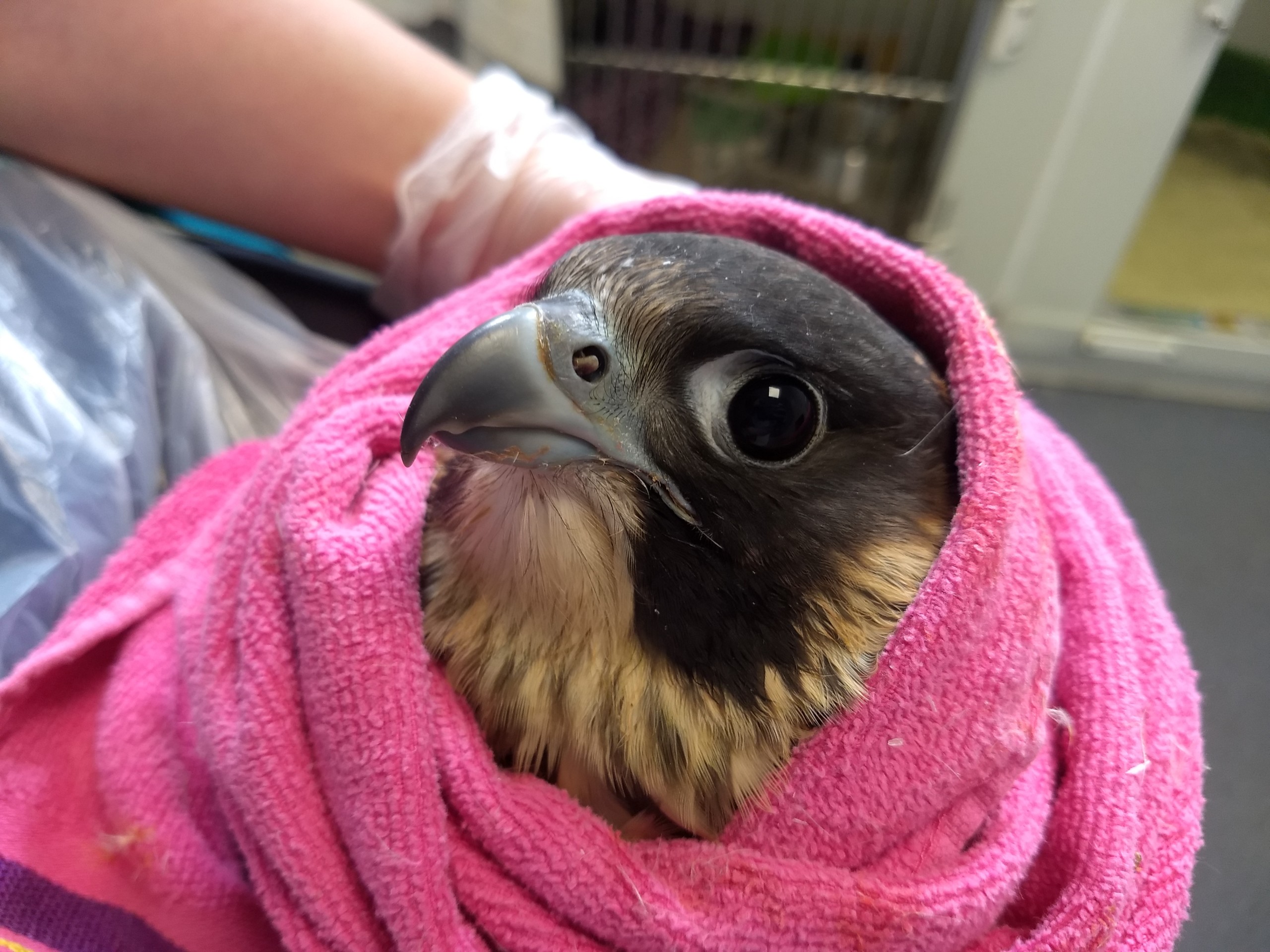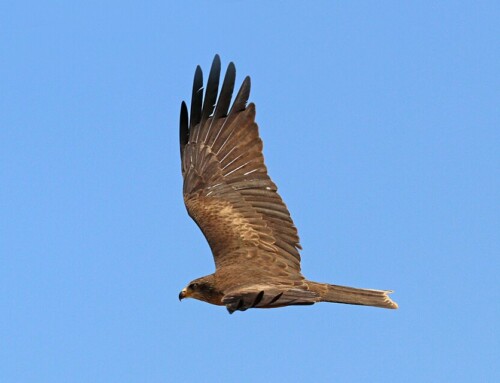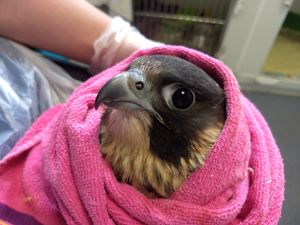 LINKED PAPER
LINKED PAPER
Causes, temporal trends, and the effects of urbanization on admissions of wild raptors to rehabilitation centers in England and Wales. Panter, C.T., Allen, S., Backhouse, N., Mullineaux, E., Rose, C-A. & Amar, A. 2022 Ecology and Evolution. doi: 10.1002/ece3.8856 VIEW
Understanding the spatial and temporal distribution of threats to wildlife is essential for effective conservation and population monitoring activities (Hernandez et al. 2018). This information is particularly important for species of conservation concern or those at high positions within ecological trophic networks such as raptors (Buechley et al. 2019). Raptors often face numerous threats from human activities such as direct and indirect poisoning (Panter et al. 2021), electrocution on powerlines, road collisions and persecution (Murgatroyd et al. 2019). However, species-threat combinations are complex and may not be evenly distributed throughout time and space.
Data from wildlife rehabilitation centres provide on-the-grounds records of causes of injury and death and can provide a snapshot of the threats facing wildlife within a local area (Molina-López et al. 2011). These data are often collated by the centres themselves but are rarely published due to the amounting time constraints imposed on rehabilitation staff and volunteers – who devote their time to helping wildlife often working unsociable hours. Therefore, a data-driven mismatch persists between rehabilitators and ecologists/conservationists – through no fault of their own!
We decided to unlock some of the potential of these data by answering the following research questions:
- What are the main causes of admissions in wild, native raptors in England and Wales?
- Have these admission causes changed over time?
- Is there a relationship between admission cause and urbanisation?
What did we do?
We compiled and analysed admissions data for native raptors that were admitted to four wildlife rehabilitation centres across western England and Wales including Gower Bird Hospital (Swansea, Wales), Cuan Wildlife Rescue (Shropshire, England), Secret World Wildlife Rescue (Somerset, England) and Wild Wings Birds of Prey (Warrington, England) (Fig. 1).
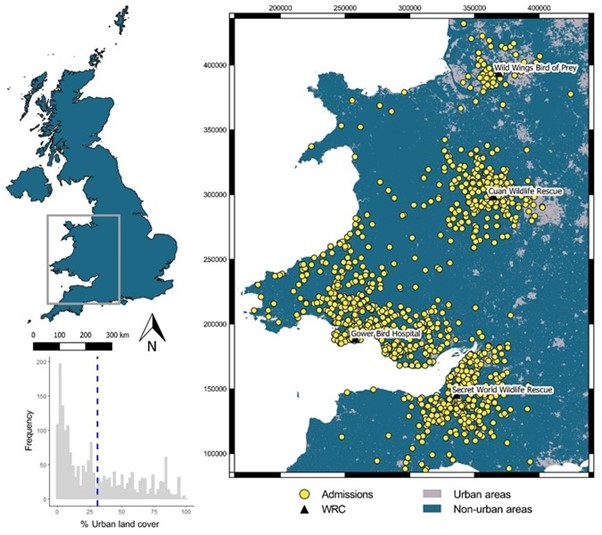
Figure 1 Spatial distribution for 14 species of diurnal and nocturnal raptors admitted to four wildlife rehabilitation centres (WRC) between 2001 and 2019 in England and Wales. Geo-referenced admissions with 2-km buffers (N = 1915) shown in relation to urban land cover. Histogram shows the frequency of urban land cover scores within each 2-km buffer and the mean (31%) denoted by the blue dashed line. Map Coordinate Reference System: EPSG 27700 British National Grid..
For each admission record, we extracted the following data: 1) species, 2) sex, 3) age, 4) date, 5) admission cause, 6) location of incident, 7) outcome (deceased/released/kept captive). Using the location of the incidents, admissions were geo-referenced and assigned a geographical coordinate based on the information provided by the finder. Making sense of every admission cause was challenging, therefore, we reclassified these into three broad admission types: ‘human’, ‘natural’ or ‘unknown’.
For example, human admission causes included: individuals attacked by pets, road and building collisions, electrocution, entanglement in netting or fencing, direct habitat destruction and persecution. Natural admission causes included: infection or parasites, starvation and emaciation, orphaned young birds and predation. Unknown admission causes included: unknown trauma and undetermined (where there were no obvious signs of injury and actual admission cause was unknown). Using a series of Generalised Linear Models, we explored temporal trends in admissions to Gower Bird Hospital as this was the only centre with the longest run of data over a 19-year period (2001-2019).
Urban sprawl is increasing throughout the United Kingdom, especially in England. Therefore, we explored the effects of urbanisation on causes of admission by calculating the proportion of urban land cover within 2km buffer circles located around each geo-referenced admission location at 25 metre resolution. This enabled us to obtain a “proportional urbanisation score” for each geo-referenced admission.
What did we find?
In total, we obtained 3,305 raptor admissions comprising of 14 native species to England and Wales. Of these, 58% (1,919) were diurnal and 42% (1,386) were nocturnal raptors.
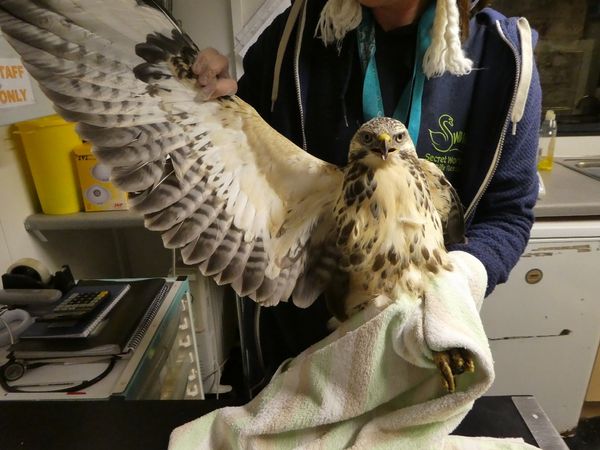
Figure 2 A Common Buzzard (Buteo buteo) undergoing initial assessment at Secret World Wildlife Rescue.
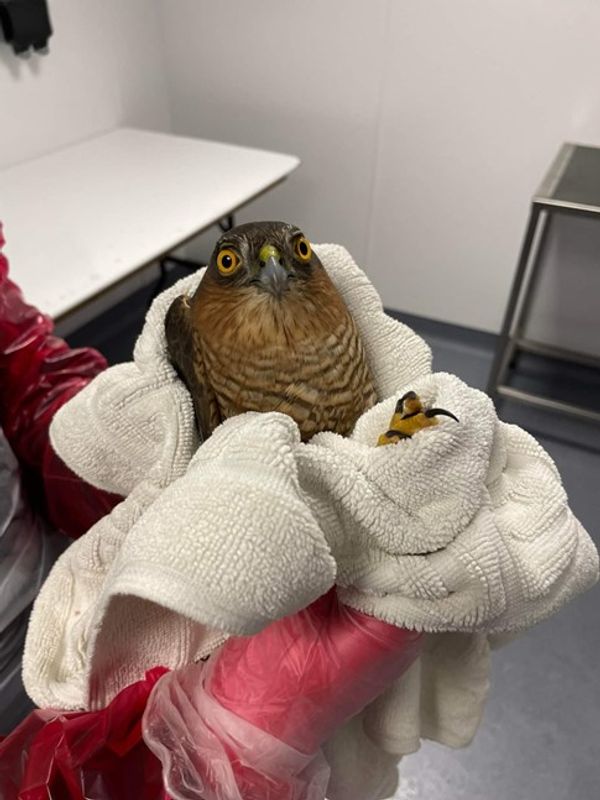
Figure 3 Eurasian Sparrowhawk (Accipiter nisus) recovering at Secret World Wildlife Rescue after colliding with a window.
Admissions of diurnal raptors consisted of nine species, the Common Buzzard (Buteo buteo; N = 1,035; 31%) (Fig. 2) being the most frequently admitted species followed by the Eurasian Sparrowhawk (Accipiter nisus; N = 457; 14%) (Fig. 3) and the Common Kestrel (Falco tinnunculus; N = 269; 8%). For the five nocturnal raptors admitted, the Tawny Owl (Strix aluco; N = 967; 29%) was most numerous within our admissions data followed by the Western Barn Owl (Tyto alba; N = 283; 9%) and the Little Owl (Athene noctua; N = 118; 4%) (Fig. 4).
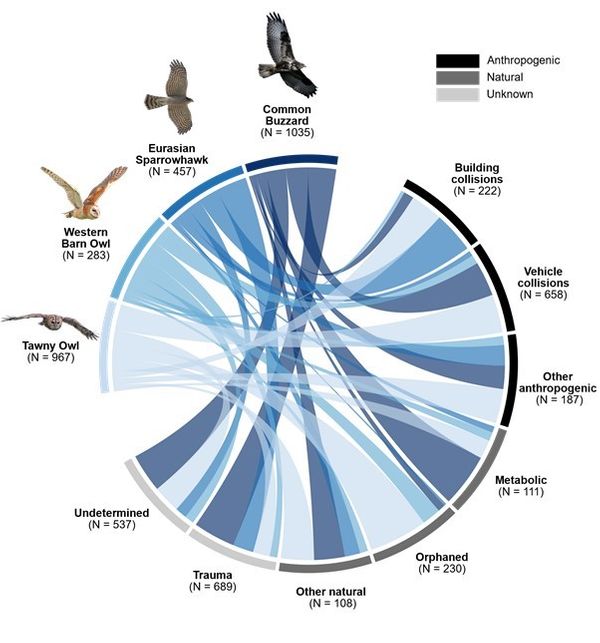
Figure 4 Admission causes for the top two most common diurnal and nocturnal raptor species admitted to four wildlife rehabilitation centres between 2001 and 2019 (N = 3011). Only the two most common admission causes per type (anthropogenic/human, natural, and unknown) shown, other causes pooled into respective categories: “Other anthropogenic” causes include “attacked” (N = 30), “fencing/entanglement” (N = 64), “electrocution” (N = 12), “habitat destruction” (N = 17), and “persecution” (N = 64). “Other natural” causes include “infection/parasites” (N = 84) and “predation” (N = 24).
Unknown admission types were most numerous comprising nearly half of all admissions (N = 1,510; 46%) followed by human (N = 1,215; 37%) and natural admissions (N = 580; 17%). Vehicle collisions (N = 732) were the most frequent identified admission cause totalling 22% of all admissions and 60% of human admission types. Collisions with vehicles were the most common identified cause for five species including Common Buzzard, Red Kite (Milvus milvus), Eurasian Hobby (Falco subbuteo), Tawny Owl and Western Barn Owl. For natural admissions, orphaned young birds (N = 315) were most common representing 10% of all admissions and 54% of natural admission types. Nearly half of all Tawny Owl admissions were due to orphaned young birds and were the most frequent admission cause for Common Kestrel, Little Owl and Peregrine Falcon (Falco peregrinus) (Fig. 5 and 6).
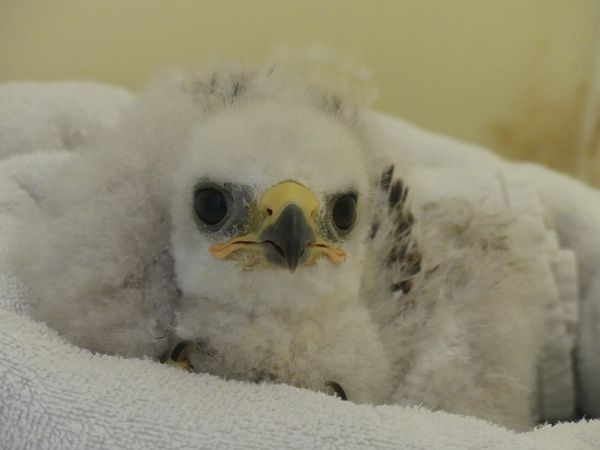
Figure 5 Common Buzzard chick admitted to Secret World Wildlife Rescue in very poor condition and covered in fly eggs.
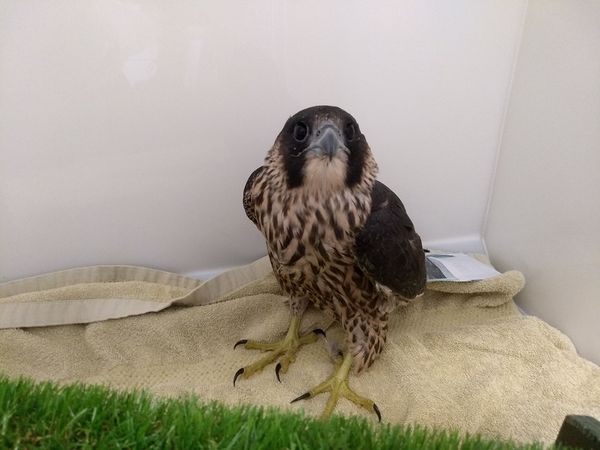
Figure 6 A Peregrine Falcon (Falco peregrinus) admitted to Secret World Wildlife Rescue after being attacked by gulls which was later transferred to a neighbouring centre.
Out of all admissions, 60% resulted in the death or euthanasia of the bird, 39% were successfully released (Video 1) and 1% remained in permanent captivity post-admission. Raptors admitted due to human causes had a significantly higher mortality rates than those admitted due to natural causes. Individuals admitted due to infection or parasites (N = 88) had the highest mortality rate of 90%, whereas, orphaned young birds experienced the lowest mortality rate of 16%.
Video 1 A Red Kite (Milvus milvus) being released into the English countryside after being rehabilitated at Secret World Wildlife Rescue.
Between 2001-2019, there was a notable decline in total admissions to Gower Bird Hospital, however, the relative proportion of human and natural admissions did not change over time. There was a significant increase in the number of admitted Red Kites and significant declines in the number of admitted Common Buzzards and Common Kestrels (Fig. 7). In our study area, there was also a decline in persecution and starvation/emaciation admissions but a significant increase in the number of orphaned young birds.
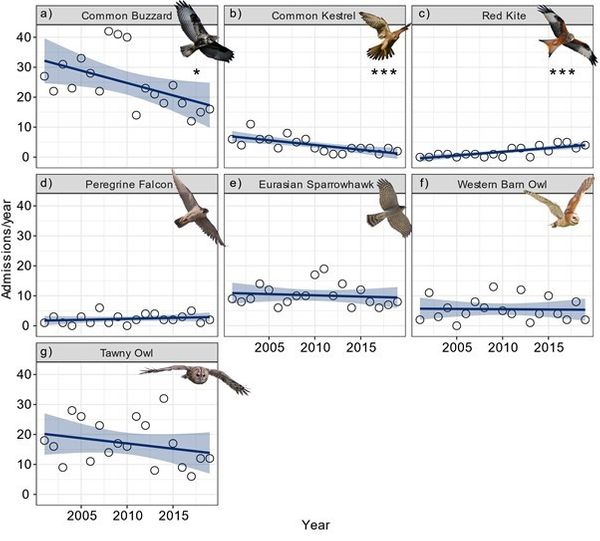
Figure 7 Trends over time for the seven most common raptor species admitted to Gower Bird Hospital between 2001 and 2019. (a) Common Buzzard (N = 470), (b) Common Kestrel (Falco tinnunculus; N = 77), (c) Red Kite (N = 34), (d) Peregrine Falcon (N = 44), (e) Eurasian Sparrowhawk (N = 193), (f) Western Barn Owl (Tyto alba; N = 105), and (g) Tawny Owl (Strix aluco; N = 323). Significant trends over time denoted by “***” = p < .001 and “*” = p < .05.
There was no relationship between proportional urbanisation and admission type (human, natural or unknown), however, we found a significant positive relationship between urbanisation and the probability of admission being caused by building collisions, persecution and unknown trauma. In the least urbanised areas, the probability of admission being attributed to a building collision was around 7% but increased to 18% in the most urbanised areas. Vehicle collisions were negatively associated with urbanisation, with a considerably higher probability of vehicle collision admissions occurring in less urbanised areas.
Compared to the relative proportion of breeding individuals in Britain and Ireland, some species were under- and over-represented within our admissions data. For example, Peregrine Falcons, Little Owls and Western Barn Owls were over-represented in our admissions data by 103%, 73% and 69%, respectively. Contrastingly, Northern Long-eared Owls (Asio otus), Western Marsh Harriers (Circus aeruginosus) and Merlin (Falco columbarius) were under-represented by 187%, 163% and 126%, respectively. But what does this mean? This suggests that some raptor species are particularly prone to human activities, e.g., Peregrine Falcons, whereas others may not be. However, this could also be due to the cryptic nature of some species such as Northern Long-eared Owls or uneven distributions of raptor populations within our study area.
Looking into the future
Many threats persist for raptors in England and Wales, however, have not changed substantially over the past two decades. Threats associated with the expansion of urban sprawl, such as building collisions, may increase over time in line with human population growth. There is plenty of scope to study how human activities affect raptor populations. Societal changes, such as reduced human activity due to the recent COVID-19 lockdowns, provide researchers with the opportunity to study changes in raptor ecology and behaviour in a world, temporarily, without humans.
References
Buechley, E.R., Santangeli, A., Girardello, M., Neate-Clegg, M.H.C., Oleyar, D., McClure, C.J.W., & Şekercioğlu, Ç.H. 2019. Global raptor research and conservation priorities: tropical raptors fall prey to knowledge gaps. Diversity and Distributions 25: 856-869. VIEW
Hernandez, C.L., Oster, S.C., & Newbrey, J.L. 2018. Retrospective study of raptors treated at the southeastern raptor center in Auburn, Alabama. Journal of Raptor Research 52: 379-388. VIEW
Molina-López, R. A., Casal, J., & Darwich, L. 2011. Causes of morbidity in wild raptor populations admitted at a wildlife rehabilitation centre in Spain from 1995–2007: A long term retrospective study. PLoS ONE 6: e24603. VIEW
Murgatroyd, M., Redpath, S. M., Murphy, S. G., Douglas, D. J. T., Saunders, R. & Amar, A. 2019. Patterns of satellite tagged hen harrier disappearances suggest widespread illegal killing on British grouse moors. Nature Communications 10: 109. VIEW
Panter, C.T., Literák, I., Raab, R., Tolhurst, B.A., & White, R.L. 2021. Age, landscape, and arrival date explain ranging behavior of wintering red kites in southwest Europe. Journal of Wildlife Management 86: 1-12. VIEW
Image credit
Top right: Peregrine Falcon (Falco peregrinus) admitted to Secret World Wildlife Rescue after being attacked by gulls © Secret World Wildlife Rescue.
If you want to write about your research in #theBOUblog, then please see here.



